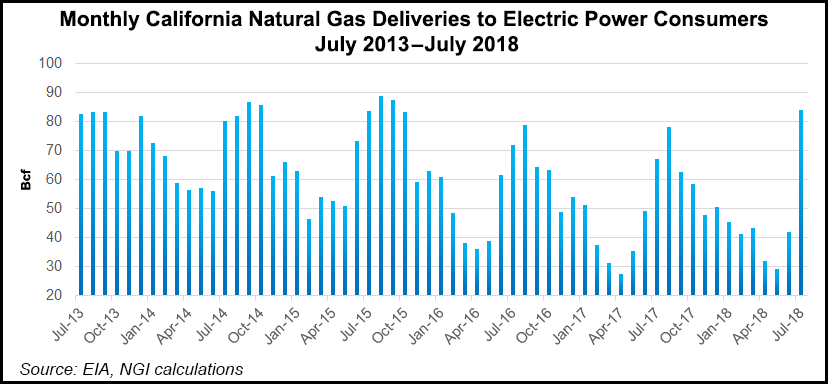Regulatory | Infrastructure | NGI All News Access | NGI The Weekly Gas Market Report
California Continues Push to Limit Gas-Fired Generation
Among hundreds of new laws signed by Gov. Jerry Brown last month are two that continue California’s push away from natural gas-fired generation to support the state’s aggressive efforts to combat the ill effects of climate change.

Senate Bill (SB) 700 refines and extends California’s self-generation incentive program (SGIP) that has been used effectively by Southern California Gas Co. (SoCalGas) as well as the state’s major electric utilities.
Last year, the California Public Utilities Commission (CPUC) revised SGIP in the midst of strong customer demand for the program that includes various gas-assisted onsite generation projects at a time of continued limitations on underground gas storage at SoCalGas’ Aliso Canyon facility in Southern California.
SB 700 extends the SGIP through 2024 along with updating the decade-old program to specify that nonrenewable fuels are no longer eligible for incentives under the program beginning in 2020. The new law calls for adoption of energy storage systems that “reduce the emissions of greenhouse gases [GHG],” presumably precluding traditional natural gas, but not renewable natural gas.
When the CPUC revised the program in May last year, it increased the budget to $500 million through 2019 with nearly 80% of that budget reserved for energy storage projects, and more than $100 million of the funds going to energy storage projects already planned the first half of 2017.
SGIP is funded by the customers of SoCalGas, plus the three major electric utilities — Pacific Gas and Electric Co., Southern California Edison Co. and San Diego Gas and Electric Co. It has traditionally provided incentives for customer investment in clean, distributed energy resources, including gas-fired combined heat and power, or cogeneration, projects.
Brown urged the CPUC to continue to administer the program so it benefits all utility customers, “including disadvantaged communities,” and should limit ratepayer-backed funding to “only what is needed to achieve the purposes of SB 700.”
The second bill signed by Brown, SB 1136, requires the CPUC in reviewing and approving utility resource adequacy plans “to ensure the reliability of electrical service while to the extent possible advancing the state’s goals for clean energy, reducing air pollution and reducing GHG emissions.”
The CPUC in reviewing and approving utility resource adequacy plans, in consultation with the California Independent System Operator (CAISO), is required by SB 1136 “to ensure the reliability of electrical service while to the extent possible advancing the state’s goals for clean energy, reducing air pollution and reducing GHG emissions.”
The new law also specifically will point toward “minimizing the need for backstop procurement from CAISO,” which often is gas-fired baseload generation, because it is the most abundant resource the grid operator has to choose from. The utility resource plans are supposed to help CAISO avoid having to use its backstop authority, a spokesperson for the grid operator told NGI.
“However, if the CAISO encounters a situation in which not enough resource adequacy has been procured, we will still use our backstop authority to fill any gaps just as we do now,” said CAISO spokesperson Steven Greenlee. “The law is intended to minimize the need for CAISO to use its backstop authority.”
© 2024 Natural Gas Intelligence. All rights reserved.
ISSN © 1532-1231 | ISSN © 2577-9877 | ISSN © 1532-1266 |
